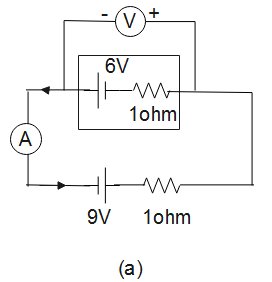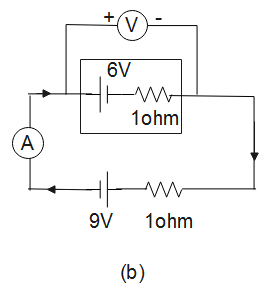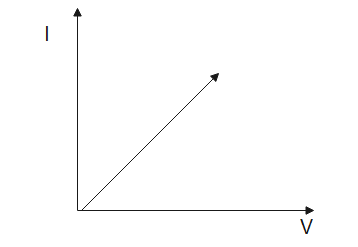
How to calculate ammeter and voltmeter readings?
In the two circuits shown in the figure, determine the readings of ideal ammeter (A) and ideal voltmeter (V):




Answer
546.9k+ views
Hint: In this question, we will use the basic ohm’s law, according to which we have relation between current, voltage and resistance of a given circuit. Now, by applying the given values and solving will give us the required result. We will also know about the basics of ohm’s law.
Formula used:
$\eqalign{& I \propto V \cr
& I = \dfrac{V}{R} \cr} $
Complete step by step solution:
According to the ohm’s law on constant temperature the current I pass through the conductor is directly proportional to the potential difference V across its ends.
$\eqalign{
& I \propto V \cr
& I = \dfrac{V}{R} \cr} $
From the circuit (a): we can see that both batteries are connected in series. So, the total voltage will be:
$\eqalign{& V = 9V + 6V \cr
& \Rightarrow V = 15V \cr} $
Now, we can see that the in series resistance is 2 ohms. So, the current is given by:
$I = \dfrac{V}{R}$
By substituting the value of voltage and the resistance in above equation we get:
$\eqalign{& I = \dfrac{{15}}{2} \cr
& \Rightarrow I = 7.5A \cr} $
Now, we find the voltage drop across top 1 ohm resistors is given by
${V_a} = I \times R$
By substituting the value of current and the resistance in above equation we get:
${V_a} = 7.5 \times 1 = 7.5V$
Since the right side is positive. So, the Voltmeter reads $ + 7.5V - 6V = + 1.5V$
Now in the given circuit (b):
In this circuit the 9 V and 6 V connected sources oppose. So, the resultant voltage is only 3V instead of 15V
we can see that both batteries are connected in series. So, the total voltage will be:
$\eqalign{
& V = 9V - 6V \cr
& \Rightarrow V = 3V \cr} $ Now, we can see that the in series resistance is 2 ohms.
So, the current is given by:
$I = \dfrac{V}{R}$
By substituting the value of voltage and the resistance in above equation we get:
$\eqalign{
& I = \dfrac{3}{2} \cr
& \Rightarrow I = 1.5A \cr} $
Now, we find the voltage drop across top 1 ohm resistors is given by
${V_a} = I \times R$
By substituting the value of current and the resistance in above equation we get:
${V_a} = 1.5 \times 1 = 1.5V$
Since the right side is positive. So, the Voltmeter reads $ + 1.5V + 6V = + 7.5V$
Therefore, we can conclude that in circuit (a) voltage is 1.5V and current is 7.5A, whereas in circuit (b) voltage is 7.5V and current is 1.5A.
Additional information:
As we know if we Plot V-I Graph comes out to be a straight line. It experimentally verified Ohm's law.

So, we can say that ohm’s law doesn't hold under all conditions like non-constant temperature and pressure. So, ohm’s law is only valid for conductors.
Note:
We should remember that there are limitations to the Ohm’s law. They are valid only for conductors not for all materials. We should also note that resistance is inversely proportional to the flow of current. The unit of resistance is ohm, named after the scientist.
Formula used:
$\eqalign{& I \propto V \cr
& I = \dfrac{V}{R} \cr} $
Complete step by step solution:
According to the ohm’s law on constant temperature the current I pass through the conductor is directly proportional to the potential difference V across its ends.
$\eqalign{
& I \propto V \cr
& I = \dfrac{V}{R} \cr} $
From the circuit (a): we can see that both batteries are connected in series. So, the total voltage will be:
$\eqalign{& V = 9V + 6V \cr
& \Rightarrow V = 15V \cr} $
Now, we can see that the in series resistance is 2 ohms. So, the current is given by:
$I = \dfrac{V}{R}$
By substituting the value of voltage and the resistance in above equation we get:
$\eqalign{& I = \dfrac{{15}}{2} \cr
& \Rightarrow I = 7.5A \cr} $
Now, we find the voltage drop across top 1 ohm resistors is given by
${V_a} = I \times R$
By substituting the value of current and the resistance in above equation we get:
${V_a} = 7.5 \times 1 = 7.5V$
Since the right side is positive. So, the Voltmeter reads $ + 7.5V - 6V = + 1.5V$
Now in the given circuit (b):
In this circuit the 9 V and 6 V connected sources oppose. So, the resultant voltage is only 3V instead of 15V
we can see that both batteries are connected in series. So, the total voltage will be:
$\eqalign{
& V = 9V - 6V \cr
& \Rightarrow V = 3V \cr} $ Now, we can see that the in series resistance is 2 ohms.
So, the current is given by:
$I = \dfrac{V}{R}$
By substituting the value of voltage and the resistance in above equation we get:
$\eqalign{
& I = \dfrac{3}{2} \cr
& \Rightarrow I = 1.5A \cr} $
Now, we find the voltage drop across top 1 ohm resistors is given by
${V_a} = I \times R$
By substituting the value of current and the resistance in above equation we get:
${V_a} = 1.5 \times 1 = 1.5V$
Since the right side is positive. So, the Voltmeter reads $ + 1.5V + 6V = + 7.5V$
Therefore, we can conclude that in circuit (a) voltage is 1.5V and current is 7.5A, whereas in circuit (b) voltage is 7.5V and current is 1.5A.
Additional information:
As we know if we Plot V-I Graph comes out to be a straight line. It experimentally verified Ohm's law.

So, we can say that ohm’s law doesn't hold under all conditions like non-constant temperature and pressure. So, ohm’s law is only valid for conductors.
Note:
We should remember that there are limitations to the Ohm’s law. They are valid only for conductors not for all materials. We should also note that resistance is inversely proportional to the flow of current. The unit of resistance is ohm, named after the scientist.
Recently Updated Pages
A man running at a speed 5 ms is viewed in the side class 12 physics CBSE

The number of solutions in x in 02pi for which sqrt class 12 maths CBSE

State and explain Hardy Weinbergs Principle class 12 biology CBSE

Write any two methods of preparation of phenol Give class 12 chemistry CBSE

Which of the following statements is wrong a Amnion class 12 biology CBSE

Differentiate between action potential and resting class 12 biology CBSE

Trending doubts
What are the major means of transport Explain each class 12 social science CBSE

Which are the Top 10 Largest Countries of the World?

Draw a labelled sketch of the human eye class 12 physics CBSE

Explain sex determination in humans with line diag class 12 biology CBSE

Explain sex determination in humans with the help of class 12 biology CBSE

Differentiate between homogeneous and heterogeneous class 12 chemistry CBSE




